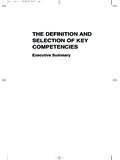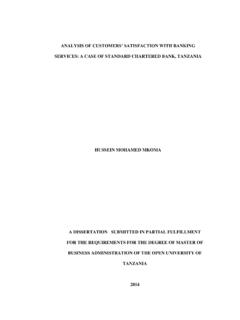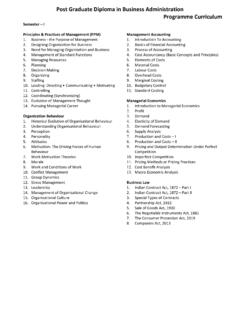Transcription of BIS Working Papers
1 BIS Working Papers No 1003 Global production linkages and stock market comovement by Raphael Auer, Bruce Muneaki Iwadate, Andreas Schrimpf and Alexander Wagner Monetary and economic Department February 2022 JEL classification: F10, F36, F65, G10, G12, G15. Keywords: financial integration, global value chains, international asset pricing, international trade, real integration, spillovers, stock market comovement, supply chains BIS Working Papers are written by members of the Monetary and economic Department of the Bank for International Settlements, and from time to time by other economists, and are published by the Bank.
2 The Papers are on subjects of topical interest and are technical in character. The views expressed in them are those of their authors and not necessarily the views of the BIS. This publication is available on the BIS website ( ). Bank for International Settlements 2022. All rights reserved. Brief excerpts may be reproduced or translated provided the source is stated. ISSN 1020-0959 (print) ISSN 1682-7678 (online) Global Production Linkagesand Stock Market Comovement Raphael AuerBIS & CEPRB ruce Muneaki IwadateBaruch CollegeAndreas SchrimpfBIS & CEPRA lexander WagnerUZH, CEPR, ECGI, SFIThis version: February 14, 2022 AbstractAlthough real integration conceptually plays an important role for the comovement of interna-tional equity markets, documenting this link empirically has proven challenging.
3 We constructa new dataset of theory-guided, relevant measures of bilateral trade in final and intermediategoods and services. With these measures, we provide evidence of a strong link between changesin real integration in particular global value chains and equity market comovement. Thisalso holds when controlling for financial openness and other factors that could confound therole of real openness. These results suggest that supply chain disruptions, for instance due topolitical tensions and the COVID-19 crisis, might also affect the interconnections between stockmarkets via rippling through the global production Classification: F10, F36, F65, G10, G12, : financial integration, global value chains, international asset pricing, internationaltrade, real integration, spillovers, stock market comovement, supply chains We are grateful to Thomas Drechsel, Giovanni Lombardo, and Karen Lewis for comments, and particularlyIvan Petzev for many earlier conversations about related topics.
4 Seminar participants at the Central Bank ResearchAssociation Conference, the European Commission and the BIS provided helpful comments. Adam Cap deliveredexcellent research assistance. The views in this article are those of the authors and do not necessarily represent those ofthe Bank for International Settlements (BIS).1 IntroductionA perennial issue in international finance is to understand how the forces of globalization shapethe international comovement of asset returns, in particular that of stock markets (see, thesurveys by Karolyi and Stulz (1996) or Lewis (2011)). In this literature and despite ample ev-idence of the impact of trade tensions on valuations1or the supply chain ripple effects of policyshocks2 there has been surprisingly little empirical evidence that the overall comovement of assetreturns can be traced to international trade in goods and services.
5 By contrast, the literature seemsto have converged to a view that asset price comovement largely owes to financial perspective, widely known for instance by the work of Rey (2013), takes credence from theprocess of capital account liberalization starting from the 1980s that resulted in reduced frictionsto international portfolio flows and allowed for a greater ease of cross-country asset paper revisits the role of real integration as an economically significant driver of interna-tional asset return comovement. It overturns some of the previous dismal findings in this literatureregarding the role of trade. Figure 1 gives a preview of our central result.
6 [InsertFigure 1]The left-hand panel of Figure 1 summarizes the glaring lack of a link between trade opennessdefined as (exports+imports)/GDP and equity market comovement the literature has scatter plot follows the spirit of the approaches summarized for example in Bekaert, Harvey,Kiguel, and Wang (2016) s survey of the literature, who demonstrate that, once a time trend isincluded, there is no relation between this and other measure of openness and measures of equitymarket contrast, the right-hand panel of Figure 1 presents a scatter plot relating the same index of1 Desai and Hines (2008), for example, document stock price losses for US exporting firms after the European Unionrequested that the World Trade Organization declare US export subsidies illegal.
7 Several studies document the impactof recent US-Chinese trade tensions (or the expectations thereof) for the stock prices of internationally-oriented firms(see, , Wagner, Zeckhauser, and Ziegler (2018), Huang, Lin, Liu, and Tang (2019), and Ramelli and Wagner (2020) inthe context of supply chain exposure to China).2 See di Giovanni and Hale (2020).3 Bekaert et al. (2016) use three measures of trade openness: an index of the country s compliance with IMF ArticleVIII rules on restrictions on international trade of goods and services; a trade restriction index building on Sachs, Warner, slund, and Fischer (1995); and the sum of exports and imports divided by GDP of the current calendar year.
8 In a similarvein, Baele and Soriano (2010) conclude that the increase in equity market comovement the last decades have witnessedmainly arises from financial rather than economic market comovement to a theory-derived measure of bilateral international input-output link-ages. This index is constructed from a dataset of bilateral trade linkages in final and intermediategoods and services, which are aggregated into indices of trade openness as they should matter forinternational profit comovement based on the predictions of neoclassical models of internationaltrade (ultimately deriving from Krugman (1979)).In comparison to more aggregate measures of trade interlinkages examined in prior work, ournovel angle is hence to study real interconnectedness via bilateral measures of trade in final andintermediate goods and services, and to show how they need to be aggregated in the presenceof reciprocal production linkages.
9 The starting point of our analysis is to assemble a data set onglobal value chain (GVCs), which we combine with data on bilateral stock market Section 2, we present a simple model of international trade guiding us how to constructtwo empirical measures of intermediate goods and final goods trade intensity (ITIandFTI, re-spectively) that matter for stock market comovement. The main mechanism operates via sales inexport markets as well as cost linkages, and is quite intuitive: if a firm is based in country A andexports to country B, an idiosyncratic demand shock in country B will also affect export sales offirms based in A. This in turn will also depress profits and stock prices in country A, and induce aco-movement in the two country s stock markets.
10 A second link arises from the input-cost channel:if a firm in country A sources inputs from B, a negative productivity shock in B will slow produc-tion down also in A, thus again leading to co-moving stock market returns. And, in a network ofglobal input-output trade, third-country effects exist as model-implied indices of real integration allow us to resurrect international trade asan important and robust driver of equity market comovement, besides financial integration. Inour empirical analysis, we merge several datasets of bilateral final and intermediate goods tradelinkages that have hitherto not been used in the literature on asset market obtain three main empirical , as a preliminary analysis, we show there aresubstantial differences betweenITIandFTIon the one hand and traditional openness measures,4 Our model abstracts from financial factors.















